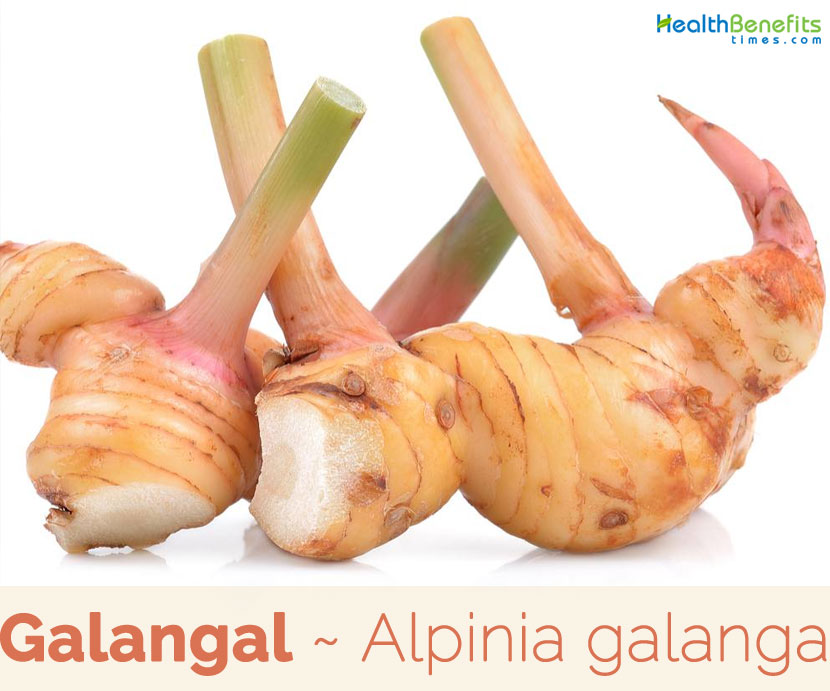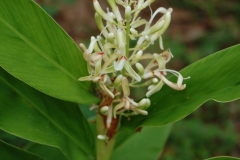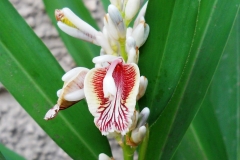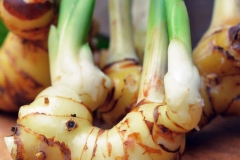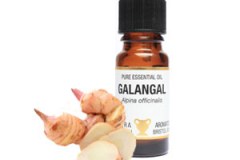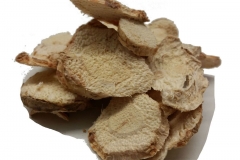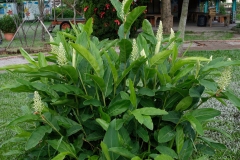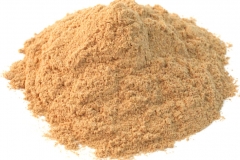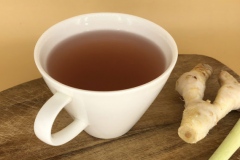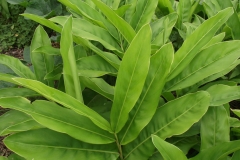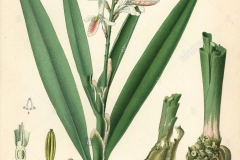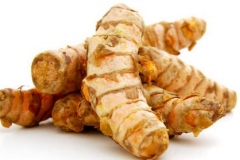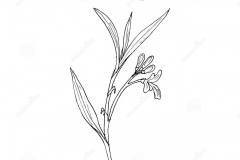Plant Description
Galangal is a robust, vigorous, tillering, perennial, herbaceous plant that grows about 2 – 3.5 meters tall. The plant is found growing in forests, scrub or grasslands. It prefers a rich, well-drained soil high in organic matter and grows well in shade or partial shade. It cannot tolerate waterlogged soils or drought. Roots are tuberous and slightly aromatic. Rhizomes are sub terete, creeping, copiously branched, 3–5 cm in diameter, fibrous, hard, shiny pink, greenish, red or pale yellow and aromatic. Pseudo stems are erect formed by the rolled leaf sheaths. For culinary use, the rhizome is typically cut up into small pieces, thin-sliced, pounded into a paste, or dried and powdered for inclusion as a flavoring in a variety of food dishes such as soups and curries. It is reportedly one of the most frequently used spices in Thai cooking, and is also quite popular in Malaysia, Singapore and Indonesia. Despite being closely related to ginger, galangal has more of a citrus, earthy or pine flavor, and each type has different nutritional compositions. The rhizome of this plant has rings around it and is pale yellow or white in color. It looks similar to both ginger root and turmeric and is often mistaken for them.
The branched are cut while fresh, and the pieces are usually cylindrical, marked at short intervals by narrow, whitish, somewhat raised rings, which are the scars left by former leaves. They are dark reddish-brown externally, and the section shows a dark center surrounded by a wider, paler layer which becomes darker in drying. Their odor is aromatic, and their taste pungent and spicy. They are tough and difficult to break, the fracture being granular, with small, ligneous fiber interspersed throughout one side. The drug is exported, chiefly from Shanghai, in bales made of split cane, plaited, and bound round with cane. Root has been used in Europe as a spice for over a thousand years, having probably been introduced by Arabian or Greek physicians, but it has now largely gone out of use except in Russia and India. Closely resembling ginger, it is used in Russia for flavoring vinegar and the liqueur ‘nastoika’: it is a favorite spice and medicine in Lithuania and Estonia. Tartars prepare a kind of tea that contains it, and it is used by brewers. The reddish brown powder is used as snuff, and in India the oil is valued in perfumery.
Leaves
Leaves are alternate in two rows with sub orbicular ligule and 1 cm long hairy petiole. Leaf blade is oblong lanceolate, 25–60 long by 6–15 cm wide, glabrous or abaxially pubescent, base attenuate, apex acute or acuminate.
Flower & Fruit
Flower is yellowish-white to greenish- white and fragrant with tubular calyx and corolla. Labellum is white with red lines, obovate-spatulate, with a deeply bi-cleft apex and purple subulate or linear lateral staminodes at the base of the labellum. Stamen is single and erect with incurved anther. Fertile flowers are followed by globose to ellipsoid capsule that is 1–1.5 cm long and 0.7 cm wide with 3–6 seeds. Fruits are initially orange-red to dark red, and turn black at maturity. Three dark brown seeds have rather unpleasant taste.
Health Benefits of Galangal
The most impressive health benefits of galangal are its ability to act as an anticancer and anti-inflammatory agent, strengthen the immune system, increase sperm motility, and protect the brain. Listed below are some of the well-known health benefits of Galangal
1. Chronic Disease
Chronic disease is often the result of chronic inflammation and the negative effects of free radicals. With the half-dozen antioxidants present in this spice, your risk of arthritis, diabetes, and coronary heart disease decreases remarkably.
2. Preventing Heart Disease and Cardiovascular problem
In blood circulatory system galangal decreases the cardiac contractions, cardiac output by increasing the blood supply to the gastrointestinal system and other vital organs. In Ayurvedic or Indian medication, galangal often served as heart disease traditional drug. Galangal is found as the best home remedy to prevent heart stroke in German-speaking countries such as Germany, Austria, and Switzerland. Even Dr Strehlew, the author of Bingen’s medicine mentioned galangal as a life saver from heart attacks. He is the one who promotes the usage of galangal in modern medication especially in promoting healthy heart to young generation.
3. Prevent inflammatory and Arthritis
Several researches have shown that galangal consist of anti-inflammatory substances called gingerols which prevent prostaglandin syntesys and inhibit histaminic also serotonic pathways. This anti-inflammatory response of galangal can serve the beneficial in reduce the symptoms of arthritis and rheumatoid arthritis treatment. Rheumatoid arthritis is a condition of joint disorder which caused by inflammation and as an effect of long lasting autoimmune disorder.
4. Prevent from tumor and cancer
Galangal is host of numerous antioxidants substance which help to minimize DNA damaged caused by free radicals and other toxin component that enter the body. Research by UK researchers found that galangal extract has anti-cancer activities according to experiment with people who suffering lung and breast cancer. The most antioxidative component in galangal that fight with free radicals is flavonoid called galangin. Galangin can modulate the activity of enzyme and suppresses chemicals geno-toxicity. It showed that galanga is very potential herbs which act as anti-cancer. Other research also reported that the transconiveril diacetate, acetoxy chavikol acetat and asetoksi eugenol cetat can prevent the pathway of Xanthin enzyme synthesize which trigger tumor development.
5. Relieves Discomfort caused by digestive problem
Dietary fiber and phyto-chemical in galanga helps to increase the process of food mixing in stomach. It also helps to reduce salivary and digestive acid secretion which gives problem to people with ulcers. Consuming galangal can give comfortable feeling to individual’s stomach who suffers from ulcer. It is also believed that galanga can prevents anorexia and abdominal pain. In Java Island, Indonesia the fresh grated galangal is given on empty stomach by adding little salt. It is supposed that grated galangal can cure enlarged spleen and relieve discomfort feeling in stomach.
Strong aromatic odor of galangal can treat nausea. Beside those effects, galangal is also thought to have carminative affect which relieving flatulence. There is no specific recommended dosage of galangal but 1 gram of tuber can be used as carminative.
6. Relieve Asthma
Galangal plays an important role in maintaining healthy respiratory system. Galangan which has been used as drug has an antispasmodic effect that reduces the sputum (Kapha) and dilates the bronchioles in order to alleviate asthma. It can also be used for speech imperfections such as dysarthria, stammering and aphasia.
7. Lowering Blood lipid and cholesterol
Researchers from China have reported that galanga extract could effectively inhibit fatty-acid synthase. Galanga is thought to prevent the mechanism of fat synthesis by its flavonoid, such as galangin, quercetin and kaempferol. While researchers in Korea also displayed that galanga extract considerably lowered the Triglycerde and cholesterol.
8. Get rid of sea, motion, and morning sickness
Chewing galanga flesh is believed to cure motion sickness. Aromatic oil in galanga can stimulate and calm the nervous system. Pregnant woman commonly experience morning sickness. Drinking brewed galangal slices with warm water and honey can help to relieve morning sickness.
9. Cure for Diarrhea
Galangal has anti-bacterial effect which can get rid of pathogen bacteria and cure diarrhea. Research showed the antimicrobial activity of various extracts of galangal to some strain of food borne pathogenic bacteria such as Escherichia coli, Salmonella enteriditis, Clostridium perfringens, Staphylococcus aureus, Campylobacter jejuni, Bacillus cereus which are the cause of diarrhea.
10. Reduce urination in polyuria
In urinary system galangal slightly reduces the ability of urine production and used as treatment in polyuria and other urine disorder.
11. Keep the body stamina
People in Indonesia used to mix galangal with other ingredients such as garlic, pepper, tamarind and etc. to produce tonic which they called “jamu”. This tonic is supposed to keep body stamina if being consume three times a day and help to relives muscle fatigue.
12. Used for impotency
It is said that keeping a piece of galangal in mouth can encourages sexual desire. In Arabian countries galangal are used as aphrodisiac and people in South-East Asian countries often use galangal in the treatment of menstrual disorder.
13. Protect the body from cold
External application and consumption of galanga powder reduces hyper respiration and coldness due to circulatory failure. An experience of doctor who travels in Nepal said that galangal is immediate reliever against cold by improving blood circulatory and produce warm feeling.
14. Relieve cough, sore throat and clearing sound
Galangal has expectorant action and is useful in many respiratory problems, particularly for children who are suffering from whooping cough. People mix the galangal extract with hot water to relieve chest pain, sore throat and clearing voice in India. Just mix some galangal powder or brew the galangal slices in boiled water with lime. It can be a tonic which can relive cough and throat problem.
15. Relieve Catarrh
Catarrh is a condition of excessive mucous production in nasal cavity which caused by inflammation of the mucous membrane. Catarrh is a symptom when a person suffers from cold or flu. Powder of galangal can be used as snuff that helps to get rid catarrh. Just solve 15-30 grams of galangal powder into hot water then sniff it.
16. Reduce ear pain
Sometime infection in ear disturbs our activity and it can be severe if we just let the pain remain in ear. Galangal can help to reduce pain in ear which is cause by inflammation. Just grate some galangal and squeeze the liquid from it then drop it to your ear.
17. Strengthen hair roots and promotes healthy hair
Cardiovascular effect of galangal also shows the benefit to the growth of hair root. Healthy cardiovascular effect of galangal improves the transport of oxygen to hair root and enhances the strength of the hair.
18. Strengthen Immune System and Anti-HIV
Research has proven that polysaccharide extract of galangal which solved in hot water possesses a stimulating effect on the reticulo endothelial system (RES) cell development and increased the number of peritoneal exudates cells and spleen cells which play role in body immune system. Research by Ye Ying Li Bao reported that 1′S-1′-acetoxychavicol acetate which isolated from galangal extract has Anti human immunodeficiency virus type 1 and blocking the replication of the virus.
19. Reduce symptom of osteoarthritis
Research which used randomized double-blind placebo controlled, the concentrated extract of galangal has been found to reduce symptoms and pain significantly in patients with osteoarthritis and suffer severe knee pain.
20. Improves blood circulation
Herb is declared to have the ability to flush out the toxins present in your body. By doing so, galangal improves the blood circulation and allows the entrance of nutrients into the skin tissue. Similarly, the antioxidant property possessed by the herb prevents the harmful toxins from being deposited in your body. As the unwanted toxins are removed from your body, the activity of your circulatory system is improved.
21. Keep the skin remain young
Cosmetic industry use galangal extract in the effort to create anti-aging formula. It is not a big deal since we know that antioxidant that contained in galangal has great impact to prevent free radicals entering the body which also promotes aging. Vitamin C in galangal also play role in skin cells rejuvenation and keep the skin away from aging.
22. Protect the liver from toxicity of chemical
Supplement of galangal is also found has a potential effect to protect liver against chemical side effect such as the usage of paracetamol. So adding some galangal to your dish is one of best way to protect heart and liver.
23. Prevent Alzheimer disease and mental fatigue
Alzheimer, a damage in brain function as one symptom of dementia is a shocking disease. Galangal has potential effect in preventing Alzheimer after some researcher found that galangal herb enhance cognitive and boost brain memory.
24. Get rid of Acne and acne scar
If you having problem with acne, galangal can be a home remedy to remove acne and dark spot. Drinking galangal juice or rubbing the galangal flesh on skin can slowly reduce acne and skin dullness.
25. Increasing Appetite
Galangal herb can also be used to increase appetite and this is why some dish which use galangal is more mouthwatering to be eaten and the effect of galangal in calming the digestive system can make someone enjoy the meal well.
26. Cure some skin problem and allergy
Roots of galanga can directly be used to rub some skin area which infected by fungi. In java, an island of Indonesia, people used to rub galanga in a white spot area caused by skin fungus which people in Indonesia called “panu” with galanga slice. It is also known that galanga can be used to cure other skin problem such as eczema, burn and itchy skin by applying the flesh on skin 2 – 3 times a day. If you have allergy to shrimp, fish or any other seafood and it makes your skin itchy, drinking galangal tonic or tea everyday can slowly remove your allergy.
27. Remove dandruff and scalp problem
Anti-fungal effect of galangal can be applied to almost area of skin which infected by fungi none of the less the scalp. Fungi can infect the scalp and resulting dandruff. You can directly rubbing the it on scalp or mix some grated galangal with olive oil then spread it on the area of scalp which infected by fungi.
28. Treats infertility
It has been suggested that there has been a decrease in sperm quality in the West. With decreased sperm quality comes the possibility of infertility. Couples wishing to conceive where sperm quality low related issues have only IVF as an option. Other, less invasive methods to improve sperm quality are therefore essential. Various clinical trials have shown that galangal has the potential for increasing fertility. The way it does this is to generate spermato-genesis, the creation of sperm, thus increasing sperm count. It also increases sperm motility, which is a movement of the sperm cells.
Traditional uses and benefits of Galangal
- Galangal rhizomes have reported wide medical applications in traditional medicine in Southeast Asia.
- Galangal rhizome has been used for its emmenogogue, aphrodisiac, abortifacient, carminative, expectorant, stomachic, digestive stimulant, antiseptic, antibacterial, anti-pyretic and anti-inflammatory qualities.
- Rhizomes have been in the treatment of various ailments such as fever, cough, hiccups, asthma, bronchitis, heart diseases, chronic enteritis, renal calculus, diabetes, rheumatism, kidney disorders, rheumatism, skin diseases, dyspepsia, colic, flatulence, gastralgia, borborygmus, emesis, dysentery, diarrhea, scurf, and enlarged spleen, cancers of oral cavity and stomach and cholera.
- Rhizome has also been claimed to be useful for malaria, tinea, tubular glands, pityriasis versicolor and desquamation of the sole and hands.
- It has been used as alternative medicine for anti-rheumatic activities.
- Red fruit is used in traditional Chinese medicine and has a flavor similar to cardamom.
- Rhizome has a reputation among the Arabs as Aphrodisiac.
- Rhizomes are used in rheumatism and catarrhal affections, especially in bronchial catarrh and in respiratory troubles of children in Indian indigenous medicine.
- Hongdoukou, Fructus Galangae, is the dry ripe red fruit of Alpinia galanga, which is used in the treatment of various gastric disorders, emesis and diarrhea.
- Rhizomes soaked in salt are used to quench thirst during strenuous work, and rhizome soaked in alcohol is used topically for ringworm infection on the skin in Vietnam.
- Rhizome is used to improve appetite, taste and voice in Ayurvedic medicines.
- It has also been reported to be useful in vata, bronchitis and diseases of the heart.
- Rhizomes have been used as stomachic, aphrodisiac, tonic, diuretic, expectorant and carminative and described as useful in treating headache, rheumatic pains, sore throat, sour eructation, stuttering, chest pain diabetes, burning of the liver, tubercular glands and diseases of the kidney in Unani medicine.
- Seeds are considered calefacient, stomachic, sternutatory and beneficial in colic, diarrhea and emesis in Chinese medicine.
- Rhizomes are used as carminative, anti-flatulent, antifungal and anti-itching in Thai folk medicine.
- For difficulty in urination, the paste of the rhizome, made with or without water from washing rice, is taken orally as a diuretic for cases of inability to urinate even though the bladder is full, and for pain and discomfort in urination.
- With ginger juice and honey, the rhizome is taken as a cure for coughs.
- Powdered and mixed with samone-byu and roasted salt, it is taken for chest pains and stomach pains; mixed with equal amounts of dried ginger rock salt, the powdered rhizome it is a remedy for indigestion.
- Powder is used as a snuff for catarrh.
- It prevents the cells from turning Cancerous and fights against Breast Cancer, Lung Cancer, Blood Cancer and Skin Cancer.
- It is a good herbal remedy in the treatment of digestive Disorders and increases the production of digestion fluids, eases digestion and improves the appetite.
- It is helpful in curing the problems like Nausea, Morning Sickness, and Diarrhea.
- Its anti-inflammatory properties alleviate the symptoms of Arthritis and Rheumatism.
- It offers relief from chest congestion and regulates the breathing rate.
- Galangal consists of high amount of Iron which is good for an anemic patient.
- It builds Immunity against viruses and germs.
- It is a useful herb for Oral Cavity. It acts as a mouth wash which heals Gingivitis, Sores, and Inflammation in Mouth. It combats Bad Breath and refreshes the Mouth.
- Galangal revitalizes the Hair follicles and enhances the Hair growth.
- It helps in getting rid of scalp Infections and Dandruff.
- Its anti-pyretic properties are beneficial in treating Fever.
- It also shows analgesic property lowers the body pain associated with Fever.
- It is a rich source of antioxidants and Vitamin C needed for a healthy Skin. They rejuvenate the Skin cells and keep the signs of aging away. It possesses anti-fungal property which is useful in curing Fungal Infections.
- Regular use of Galangal improves the Sperm count and Sperm motility. It increases the fertility and cures Impotence.
Ayurvedic health benefits of Galangal
- Asthma: Mix half tsp. root stock powder in 250 ml water. Leave it for 4 hours. Drink this infusion by adding 1 tsp. Honey in it.
- Chest Congestion: Soak some crushed root stock in a pot of drinking water. Drink after adding honey whenever feel thirsty.
- Cough: Take 2 cups of water. Soak 5 g crushed rhizome of Galangal for 4 hours. Add 1 tsp. honey and drink. OR: Mix the powder of Galangal root stock and sugar in equal ratio. Take half tsp. with hot milk during bedtime. OR: Make a layer of Castor oil over Galangal’s root stock. Heat until it chars. Grind it to make powder and store. Take half tsp. with honey once a day. OR: Crush Galangal’s rhizome with sugar. Have 3 gm. once a day.
- Phlegm: Add 1/2 tsp. powdered rhizome of Galangal to 2 cups of water. Keep it for 3 hours. Sweeten with 1 tsp honey before drinking. OR: Eat crushed root stock of Galangal with sugar once a day. OR: Make an infusion of Galangal’s rhizome. Filter it and add sugar. Take 10 ml thrice a day
- Cold: Take 50 g powder of each Galangal rhizome and sugar. Take 3 g during bedtime with hot milk.
- Nausea: Take Galangal’s rhizome. Dip it in Castor oil. Roast it over flame. Powder it. Take 3 g with honey daily. OR Mix equal quantity of Galangal’s rhizome powder with sugar. Eat 1 tsp. once a day.
- Gum Disease: Make a decoction of Galangal’s rhizome. Use it for gargle.
- Fever: Mix root stock of Galangal and sugar. Grind to make powder. Take half tsp. with hot water or milk during bedtime.
- Headache: Grind equal quantity of sugar and Galangal’s root stock together. Take 3 g with hot milk before sleeping.
- Muscle Spasm: Externally apply the grated Galangal as a poultice. OR : Use as a hot fomentation
- Menses Scanty: Drink hot Galangal tea half cup a day, regularly for a week. It promotes perspiration.
- Sore Throat: Chew the root stock to get relief.
- Rheumatism: Mix 4 g rhizome powder of Galangal in a cup of lukewarm water. Drink it thrice a day.
- Digestive disorders: Consume 3 g rhizome powder of Galangal before every meal.
- Aphrodisiac: Regular intake of 6 grams of Galangal root stock once a day, helps in increasing the sperm count
- Asthma: Mix in a mud pot 6 tablespoons each of Balloon Vine leaves, Climbing Brinjal and a small piece of crushed Galangal root. Add One tablespoon Cumin, 4 Black Peppers and One tablespoon dried Ginger powder. Add 3 glasses of water. Boil till reduced to One glass. Take One tablespoon twice a day.
- Cough: Mix in a mud pot 6 tablespoons each of Balloon Vine leaves, Climbing Brinjal and a small piece of crushed Galangal root. Add One tablespoon Cumin, 4 Black Peppers and One tablespoon dried Ginger powder. Add 3 glasses of water. Boil till reduced to One glass. Take One tablespoon twice a day.
- Bronchitis: Take equal quantity of Cubeb, Galangal, Licorice and Long Pepper. Grind them together. Boil two teaspoon powder in a cup of water. Add two teaspoon Honey and have lukewarm daily.
- Cough: Grind equal quantity of Cubeb, Galangal, Licorice and Long Pepper. Take one teaspoon with two teaspoon Honey daily.
- Bad breathe: Chew a small quantity crushed root stock of Galangal with Betel leaf.
- Cough: Take one tsp. powder of Galangal, Abies Spectabilis, Long Pepper, and Licorice. Add some water to make a paste. Heat it with 4 cups of water until it boils. Take this decoction, thrice a day with honey.
- Cough: Soak a small piece of Galangal root stock in 250 ml boiled water for 3 hours. Add some Date Palm sugar in it. Take 3 tsp. thrice a day.
- Tonsillitis: Take equal quantity of Licorice, Sweet Flag and Galangal. Grind them together. Have a teaspoon with Honey once a day
- Libido Booster: Take the dried form of 20 gram Cnidium, 20 gram Chinese Gall, 20 gram Ligusticum Wallichii Root, 20 gram Leaves and Stem of Horny Goat Weed, 20 gram Morinda Officinalis Root, 20 gram Chufa Root, 20 gram Roots and Rhizomes of Notopterygium, 20 gram Flower of Magnolia Bark, 20 gram of Galangal Rhizomes, 8 to 10 Garlic Cloves, 30 gram Schisandra Fruit, 10 gram Cinnamon Bark and 30 gram Roots and Rhizomes of Spikenard. Powder them together. Have half teaspoon with milk for a few nights. This formula boosts libido, in both men and women. Better results have been found especially in females. It warms up the body and enhances sex stamina.
Culinary Uses
- Galangal rhizome is widely used as spice.
- Rhizome is a common ingredient in soups and curries and is used fresh, frozen, dried or in powder form.
- Fresh rhizome of A. galanga has a characteristic fragrance as well as pungency; hence, its rhizome is used as an essential component in Thai curries paste.
- Fresh galangal has a pure and refreshing odor and a mildly spicy flavor; it is the galanga of choice for all Thai foods.
- Rhizome is a common ingredient in Thai soups like Tom yam, Tom Khaa and Thai, Malaysian and Indonesian curries, where it is used fresh in chunks or thin slices, mashed and mixed into curry paste, or dried and powdered.
- Spice is commonly used in Indonesian fried rice, Nasi Goreng.
- Malaysian and Indonesian beef rendang is usually spiced with galangal.
- There are many different recipes of rendang. Essentially rendang comprises chunks of beef cooked in thick coconut milk together with dried chilies, garlic, turmeric, ginger, Salam leaves and galangal.
- Some recipes used these together with cinnamon, black pepper and even fennel.
- Galangal is used as flavoring in bean curd in Java and also used in sauces.
- Essential oil from the rhizome is used to flavor ice cream, alcoholic drinks, liqueurs, cakes and pastries.
- It is used as a flavoring for beverages and spirit including nastoika, liquor in Russia.
- Flower buds, leaves and young shoots are also eaten as spice or vegetable.
- Fruits occasionally used as substitute for cardamom.
- Galangal is commonly used as a flavoring herb in many dishes of Thai cuisines such as seafood and meat dishes.
- Thin slices of galangal are added in soups along with lime leaves and lemongrass for an exquisite flavor.
- Galangal is also a chief ingredient in many spicy pastas and sauces made with garlic and chilies.
- Flowers and young shoots can be eaten raw, steamed as a vegetable, or used as a spice.
- Flowers and flower buds are eaten raw, they can also be steamed, pickled, added to soups, mixed with chili paste etc.
Selection and storage of galangal
Although galangal is harvested during the summer and fall, it is available all year round. You can buy it from Asian stores, particularly Thai grocery stores. When buying galangal, look for small ones having firm and unblemished skin. Avoid the ones that appear to be wrinkled, as they are old and dry. Smaller rhizomes are softer and tender and are easy to cut.
Unlike ginger, it is not necessary to peel galangal. Just rinse the root thoroughly under cold water and get rid of any dirt on the skin, and then pat dry. Galangal can stay fresh for up to two to three weeks when stored in the vegetable drawer of a refrigerator. To store in the refrigerator, first clean and dry the root and then wrap it in plastic wrap. It would be good if you could first wrap it in a damp cloth and then place the root in a plastic bag. Another way of storing galangal is to cut the unpeeled rhizome into small slices, wrap it in plastic wrap and freeze it. This way it will keep fresh for up to three months without losing its flavor.
Dosage and Administration
Galangal root is used as a tincture, a decoction or in powder form and as a medicine; the recommended daily dose of the herb is usually around 6 g.
As a tea: Use half to one teaspoon of the coarsely ground root in a cup of boiling water and steep for 5-10 minutes. Drink three cups daily half an hour before meals.
To enhance digestion: Use 20 drops of tincture in 1 ml of warm water three times daily. For nausea and motion sickness use the tea or 250 mg of ground root in capsules twice daily.
Other Facts
- Rhizomes also have insecticidal properties.
- Studies showed that hexane crude extract of galangal rhizome gave the highest control efficiency of adult Bactrocera dorsalis.
- Plant is the source of an essential oil, called Essence d’ Amali.
Precautions
- Avoid use during pregnancy and breast feeding.
- Fresh root is toxic and may cause dizziness, intestinal pain and vomiting.
- Do not take it with salt.
- It may increase your stomach acid, so it is best to avoid it if you are suffering from GERD or peptic ulcer
References:
https://www.itis.gov/servlet/SingleRpt/SingleRpt?search_topic=TSN&search_value=506513#null
https://davesgarden.com/guides/pf/go/60085/
https://www.drugs.com/npp/galangal.html
https://botanical.com/botanical/mgmh/g/galang01.html
https://plants.usda.gov/core/profile?symbol=ALGA2
https://www.wikidata.org/wiki/Q402971
https://npgsweb.ars-grin.gov/gringlobal/taxonomydetail.aspx?id=2666
http://www.theplantlist.org/tpl1.1/record/kew-218790
https://indiabiodiversity.org/species/show/258877
https://www.flowersofindia.net/catalog/slides/Thai%20Ginger.html
https://gd.eppo.int/taxon/AIIGA
https://en.wikipedia.org/wiki/Alpinia_galanga
https://www.haad.ae/HAAD/LinkClick.aspx?fileticket=SAk4412f778=&tabid=791
Comments
| Galangal Quick Facts | |
|---|---|
| Name: | Galangal |
| Scientific Name: | Alpinia galanga |
| Origin | India, to Southeast Asia (Indonesia, Malaysia, Myanmar, Thailand, Laos and Vietnam) to Southern China (Fujian, Guangdong, Guangxi, Hainan, Yunnan) and Taiwan |
| Colors | Initially orange-red to dark red, and turns black at maturity |
| Shapes | Globose to ellipsoid capsule, 1–1.5 cm by 0.7 cm with 3–6 seeds |
| Taste | Bitter, pungent and sweet |
| Health benefits | Treats infertility, Remove dandruff and scalp problem, Cure some skin problem and allergy, Increasing Appetite, Get rid of Acne and acne scar, Prevent Alzheimer disease and mental fatigue, Protect the liver from toxicity of chemical, Keep the skin remain young, Improves blood circulation, Reduce symptom of osteoarthritis, Strengthen Immune System and Anti-HIV, Strengthen hair roots and promotes healthy hair, Reduce ear pain, Relieve Catarrh, Relieve cough, sore throat |
| Name | Galangal |
|---|---|
| Scientific Name | Alpinia galanga |
| Native | India, to Southeast Asia (Indonesia, Malaysia, Myanmar, Thailand, Laos and Vietnam) to Southern China (Fujian, Guangdong, Guangxi, Hainan, Yunnan) and Taiwan |
| Common Names | Blue Ginger, Chinese Ginger, False Galangal, Galangal, Galangal Root, Greater Galangal, Java Galangal, Languas, Laos Root, Siamese Galangal, Siamese Ginger, Spice Ginger, Thai Galangal, Thai Ginger, Chewing John, China root, East Indian root, Galanga, Galangal root, Kulanjan, Laos, Lesser galangal, Little John chew, Lesser galangal, small galangal, galingale, gargaut, India root, east India catarrh root, ginger root, colic root |
| Name in Other Languages | Arabic : El-Galangal, El-Adkham, Khulanjane- Qasbi, Khulanjan-E-Kabir, Khulanjan Kabeer, Khowlanjan, Khulanjan, Khulanjanekabir, Khulanjaneqasbi, Khulanjane-Kabir Assamese: Karphul, Bogi-tora/ Tora-bhaghini Bengali: Kulinjan Brazil : Alpinia Bosnian : Aflidžan, Galanga , Galgan, Galgant, Kalgan, Sundska Galangal Burmese : Pa De Gaw Gyi, Padagoji Chinese : Da Gao Liang Jiang, Hong Dou Kou (紅荳蔻), Liáng jiāng (良薑), Dàliáng jiāng (大良薑), Mán jiāng (蠻薑), Nán jiāng (南薑) Croatian : Aflidžan, Galanga , Galgan, Galgant, Kalgan, Sundska Galanga Czech : Galgán, Galgan Obecný, Kalkán, Galgán Veliký, Galgán Větší Danish : Galanga, Stor Galanga, Stor Galangarod Dutch : Galgant, Galigaan, Grote Galanga, Lengoewas English: Siamese-ginger, Greater galangal, Languas, Galanga, Galanga major, Galangal, Greater galanga, Laos root, Spice ginger, thai ginger Esperanto : Galango Estonian : Suur Kalganirohi Finnish : Galangajuuri French : Galanga, Grand Galanga, Galanga De l’Inde, Galanga Majeur, Herbe Indienne, Galanga, Souchet Long, Souchet Odorant German : Galgant, Großer Galgant, Siam-Ingwer, Siamesische Ingwerlilie Greek : Galagkē, Galanki Gujarati: Kolinjan Hebrew : Galangal Hindi: Punnagchampa, Bara- Kulanjan, Barakalijan, Barakulanjan, Barakulinjan, Kulanajn, Kulanjan, Kulinjan, Saphed-Panaki-Jhad, Bara-Kalijan Hungarian : Galangagyökér, Galangál, Sziámi Gyömbér Indonesia : Lengkuwas, Laos ( Sundanese, Laja, Lawas, Langkuweh, Lengkuwas Italian : Galanga Maggiore Japanese : Garanga, Nankyo Kannada: Dhumarasmi, Doddadumprashme, Dumbarasme, Dumpa-Rasmi, Dumrashta, Rasmi, Sugandhavachi, Dumparaasme, Raasmi, Sughandavachi, Dumpa Rasme, Rasmini, Sugandhavaci, Kulinjana Doopparaasme, Dumbaraasme, Dumbraashta, Gandhamoola, Khmer : Madeng, Pras Sva, Romdeng, Rumdeng Korean : Gal-Ren-Gal, Kallengal Laotian : Kha Ta Deng Lithuanian : Alpinija Malay: Lawas, Langkuweh, Lengkuas, Lengkuas benar, Lengkuas biasa, Mengkanang, Puar Malayalam: Aratta, Chitta-Ratta, Cittaratta, Pera-Ratta, Perasatta, Peraratta Malaysia : Lengkuas, Langkuas, Lengkuas Benar, Puar, Mengkanang Manipuri: Kanghoo Marathi: Kokuliñjan, Koshtkulinjan, Kolinjan, Kulimjan Mizoram: Aichal Nepali : Tontha, Sarra Norwegian : Stor Galanga, Stor galangal, Stor galangarot, Uekte galanga Oriya: Tikshnamula Pakistan : Kulanjan, Khulanjan, Badi Khulanjan, Khulanjan Nim Kofta Persian : Xuz Rishe, Djus Rishe, Jouz Rishe, Khusrave-Durue-Kalan, Khusrodaru-EKalan, Khurduwara, Khusravedruekalan, Khusrave-Darue-Kalan Philippines : Palla, Langkawas, Langkuas Polish : Galanga Portuguese : Galanga Maior, Gengibre Do Laos, Gengibre Tailandés Russian : Al’piniia Galangal Sanskrit: Aruna, Dhumala, Dhumparastma, Dumparastma, Elaparni, Gandhamula, Gandhavaruni, Kapidruma, Koraja, Kulangana, Kulanja, Kulanjana, Kulin- Jana, Kulinjana, Mahabaravach, Mahabharavacha, Mahabhari Vaca, Mahabharivaca, Malayavaca, Nakuli, Patala, Purusha, Raktapushpa, Rasna, Sthulagranthi, Sugandha, Sugandhamula, Sugandhavacha, Sugandhayoga, Tikshnamula Serbian : Aflidžan, Galanga, Galgan, Galgant, Kalgan, Sundska Galanga Slovak : Alpínia Galangová, Alpínia Liecivá, Galgán Lekársky, Galgán, Galgán Lekársky Slovenian : Langvas Spanish : Calanga, Garengal, Galanga, Galanga Grande, Galanga Mayor, Jengibre de Siam Swedish : Galangarot, Oäkta galangal, Siamingefära, Stor galangarot Tamil: Anandam, Arattai, Ardubam, Attumam, Pera- Rattai, Kandanaguliyam, Perarathi, Thumbrashtagam, Perarattai, Tumparattam, Canna Rastakam, Tumras Takam, Periareta, Perarathai, Oramrundu, Sattiradji, Sugandam, Araddai, Peraraddai, Akkulati, Anaivacampu, Anantam, Anantatam, Ananti, Aracanam, Arppatumam, Arttupam, Arttuvam, Artupam, Atitipam, Attumam, Atumam, Cakunam, Caramarutam, Cattiratci, Cattiratti, Cencaram, Cerukkampam, Cikamatakikam, Cikamatam, Cirenki, Citakampam, Cukantam, Curacam, Curatakku, Curatakkutam, Elaparani, Erarattai, Iracana, Iracanacikam, Iracanakikam, Iracina, Iratanai, Irattaputpam, Irattarenu, Kantamulam, Kantanakuliyam, Katiyastakam, Kattiratci, Kentacamakan, Kentakanarani, Kottakarai, Kulancam, Ormaruntu, Pavanam, Purantam, Putakani, Tiritosavatakacakkini, Tittikam, Tittipam, Tittiram, Tittiyam, Tummarastakam, Tumpakam, Tumparastakam, Tumparattakam, Tumpurastakam, Tumpurattakam, Tumpurattam, Turani, Mitintarattai, Mitintu, Mulatiracam, Mutical, Nakuli, Narayanam, Natanatam, Uttamam, Vamanaci, Perearetei Tangkhul: Hirui Telegu: Sannadumparāramu, Dumparashtraamu, Kachoramu, Pedda-Dhumpa, Pedda- Dumpa- Rashtrakam, Peddadumparashtrakamu, Rash- Trakam, Dumparaashtrakamu, Peddadumparaashtrakmu Thai : Dok kha, Ginza, Khaa; Khaa-ling Tibetan : Sga-Skya Turkish : Büyük havlıcan, Galanga, Havlıcan Urdu: Kulanjan, Khulanjan, Badi Khulanjan, Khulanjan Nim Kofta Vietnamese : Cao Luong Khuong, Cao Khuong Huong, Hông Dau Khâú, Mot Loai Gung, Rieng am, Rieng Nep, Sown Nai |
| Plant Growth Habit | Robust, vigorous, tillering, perennial, herbaceous plant |
| Growing Climates | Forests, scrub or grasslands |
| Soil | Prefers a rich, well-drained soil high in organic matter and grows well in shade or partial shade. It cannot tolerate waterlogged soils or drought |
| Plant Size | 2 – 3.5 meters tall |
| Root | Tuberous and slightly aromatic |
| Rhizome | Sub terete, creeping, copiously branched 3–5 cm in diameter, fibrous, hard, shiny pink, greenish, red or pale yellow and aromatic |
| Pseudo Stem | Erect formed by the rolled leaf sheaths |
| Leaf | Alternate in two rows with sub orbicular ligule and 1 cm long hairy petiole. Leaf blade is oblong lanceolate, 25–60 long by 6–15 cm wide, glabrous or abaxially pubescent, base attenuate, apex acute or acuminate |
| Flower | Yellowish-white to greenish- white and fragrant with tubular calyx and corolla. Labellum is white with red lines, obovate-spatulate, with a deeply bi-cleft apex and purple subulate or linear lateral staminodes at the base of the labellum. Stamen is single and erect with incurved anther |
| Fruit Shape & Size | Globose to ellipsoid capsules, 1–1.5 cm by 0.7 cm with 3–6 seeds |
| Fruit Color | Initially orange-red to dark red, and turns black at maturity |
| Seed | Three dark brown seeds with rather unpleasant taste |
| Flavor/Aroma | Fruity-spicy aroma like a fir needle, while the dried version has a sweeter smell, much like cinnamon |
| Taste | Bitter, pungent and sweet |
| Plant Parts Used | Dried rhizome |
| Health Benefits |
|


